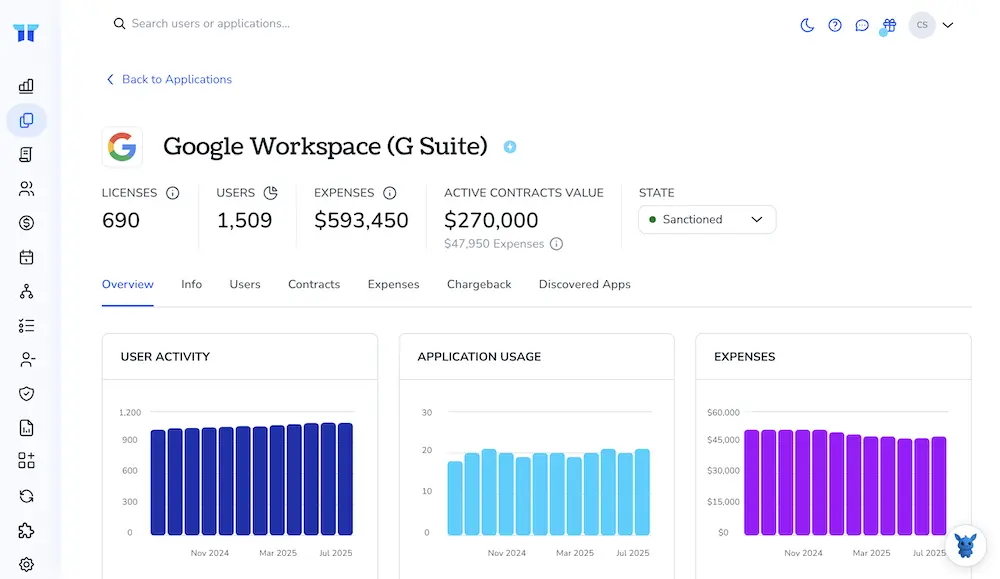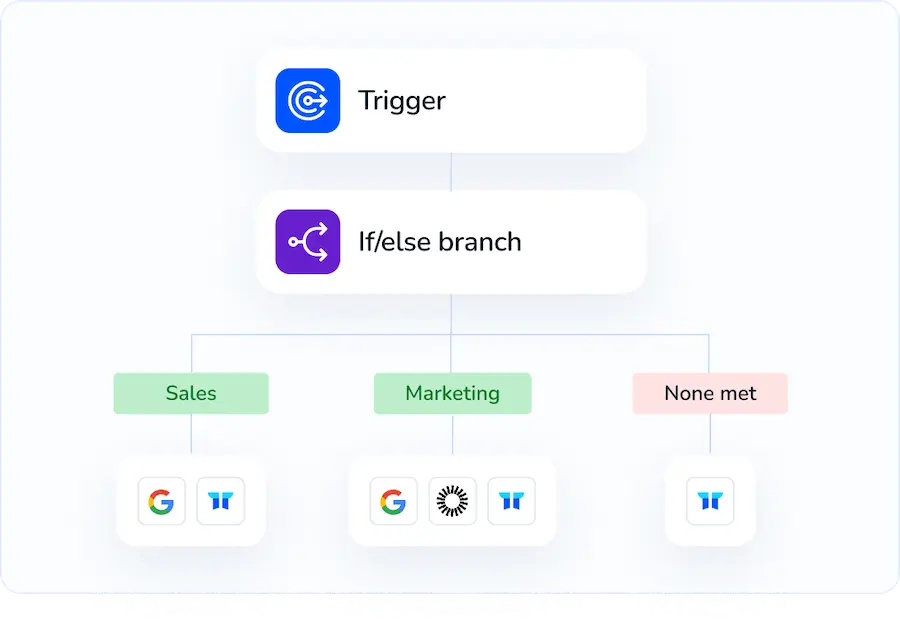3 Ways to Add Users to Google Workspace

New teammates can’t do much until they have a Google Workspace account, yet many admins jump between screens trying to add people one by one. The good news: it takes only a few clicks once you know which tool fits the situation.
In this guide we’ll walk through three ways to create users, directly in the Admin console, with a bulk CSV upload, and through automated directory sync, so you can pick the route for each hire.
Table of Contents
Use Google Workspace’s UI
Use the Google Admin console to add a new user and supply their first sign-in details.
Step 1: Sign in as an admin
- Go to admin.google.com.
- Enter your admin email and password. A Super Admin account works best here.
Step 2: Open the Users page
From the Admin console home, click Users.
If you don’t spot it right away, try the search bar at the top.
Step 3: Start the Add User flow
Click the round + button labeled Add new user.
Step 4: Enter basic profile details
- Fill in First name and Last name.
- Edit the Primary email prefix if you prefer something other than the default.
- Choose the user’s Organizational Unit when they shouldn’t sit in the top-level one.
Step 5: Set the password
- Keep the auto-generated password or click Set password to create your own.
- Leave “Ask for a password change at next sign-in” checked unless there’s a specific reason to clear it.
Step 6: Add recovery info (optional but smart)
Click Add recovery email or phone and enter something the user can reach off-domain.
This lets them reset their own password later.
Step 7: Review and create
- Check the summary.
- Click Add new user. Google shows a confirmation card with the account’s sign-in info.
Step 8: Share the credentials
- Copy the temporary password or click Email sign-in info to send it to any address you choose.
- Remind the user they’ll pick a new password the first time they log in.
Step 9: Finish up (optional)
- While you’re still on their profile, you can:
- Assign extra Google Workspace licenses.
- Add them to groups for email lists or shared drives.
- Turn on two-step verification enforcement if policy calls for it.
That’s it. Your new user is active and ready to sign in.
Use Torii
Instead of handling provisioning directly in Google Workspace, you can rely on Torii, a SaaS Management Platform, to add users to Google Workspace. SMPs give organizations clear visibility into their SaaS stack, letting teams programmatically onboard and offboard employees, review subscription details, and more.
Because Torii lets you build no-code automations, the user-creation task runs as soon as a defined trigger fires, be that a new hire, a departure, a contract anniversary, or another event. Automating this repetitive step frees up valuable admin time.
To create a user in Google Workspace through Torii, follow these steps:
1. Sign up for Torii
Reach out to Torii and request a free two-week proof of concept.
2. Connect your Google Workspace account to Torii
When your Torii instance is ready, link it to your existing Google Workspace environment. Follow this guide: Here are the instructions for the Google Workspace integration.

3. Create a Torii workflow for Google Workspace
Inside Torii, open the Workflows tab, set up the desired trigger, and add the action that creates the Google Workspace user. From then on, every time the trigger occurs, Google Workspace updates automatically.

Use Google Workspace’s API
Sometimes you need to create a Google Workspace user without opening the admin console. The Directory API’s users.insert method covers that case, and the steps below take you from enabling the API to reading the response.
1. Switch on the Admin SDK and pick your credential
- In Google Cloud, enable the Admin SDK.
- Grab one of these:
- A service account with domain-wide delegation, or
- An OAuth client ID that an admin will consent to.
Regardless of which credential you choose, you must include the scope https://www.googleapis.com/auth/admin.directory.user when requesting the token.
2. Swap your credential for an access token
Service account route
gcloud auth application-default print-access-token
OAuth route
- Send the user through the standard OAuth screen.
- Exchange the code for a token the usual way.
Keep the token handy; you’ll pass it as a Bearer header. You can reuse the same token for multiple calls until it expires in roughly one hour.
3. Build the request body
At minimum you need the email, a password, and a name object. Most other attributes are optional, so start with this straightforward JSON template and expand it as needed later.
{
"primaryEmail": "[email protected]",
"name": {
"givenName": "New",
"familyName": "User"
},
"password": "TempPa55."
}
Optional fields you might tack on later: orgUnitPath, hashFunction, changePasswordAtNextLogin, and any custom schemas your domain uses.
4. Call users.insert
curl -X POST \
-H "Authorization: Bearer ACCESS_TOKEN" \
-H "Content-Type: application/json" \
-D @new_user.json \
"https://admin.googleapis.com/admin/directory/v1/users"
Replace ACCESS_TOKEN with the value from step 2 and @new_user.json with the file holding your JSON body.
5. Read the response
If the server replies with HTTP 200, the request succeeded. The body returns the full user object, including the unique ID: You can store that identifier in your database for future updates, suspension actions, or audit reports because it never changes.
{
"id": "113355779911223300",
"primaryEmail": "[email protected]",
"isAdmin": false,
.
}
When you receive a 409 error, the email address is already in use, so pick another or clean up the existing account. A 403 often means the token lacks the right scope or the calling account isn’t an admin.
After these steps, the new user exists in your directory. They can log in immediately, or after changing the temporary password if that flag is set.
Torii for SaaS Management
Tell us if you’d like to explore SaaS management in more depth. Torii’s SaaS Management Platform helps you to:
- Find hidden apps: Use smart discovery to track shadow IT and unauthorized tools across the company.
- Cut costs: Reduce spend by reclaiming unused licenses and consolidating overlapping tools.
- Implement on/offboarding automation: Automate employee joins and exits to save time and avoid mistakes.
- Get contract renewal alerts: Receive reminders well before every renewal date.
Torii brings Finance, IT, and Security teams together on a single SaaS management workspace.
See features, case studies, and a live demo at Torii.
Frequently Asked Questions
You can add users through the Admin console's Add User flow, upload a CSV for bulk provisioning, or automate the task with Torii or the Directory API. Choose the method that fits each hiring scenario.
Yes. In the Admin console you can click Users, choose Bulk upload, download Google's CSV template, fill it with each employee's details, then import the file. Workspace instantly creates every listed account in one action.
Torii is a SaaS Management Platform that connects to Google Workspace, lets admins build no-code workflows, and triggers user creation whenever events like a new-hire record appear. Automation eliminates repetitive clicks, ensures timely onboarding, and keeps license data synchronized.
Use the Admin SDK Directory API's "users.insert" endpoint. After enabling the Admin SDK, obtain an access token with the scope admin.directory.user, craft a JSON body with email, name, and password, then POST it to /admin/directory/v1/users.
You need either a service account with domain-wide delegation or an OAuth 2.0 client ID authorized by a Super Admin. Both options must request the admin.directory.user scope before exchanging the credential for an access token used in API calls.
For security, the Admin console marks temporary passwords to be reset on first sign-in. Forcing a change ensures only the employee knows the final credential, prevents password reuse, and protects the account even if the initial email gets intercepted.

